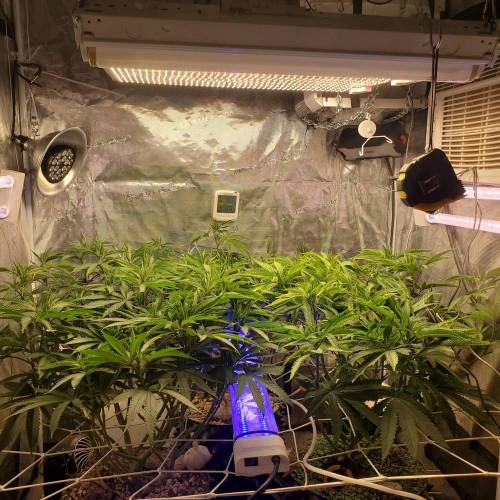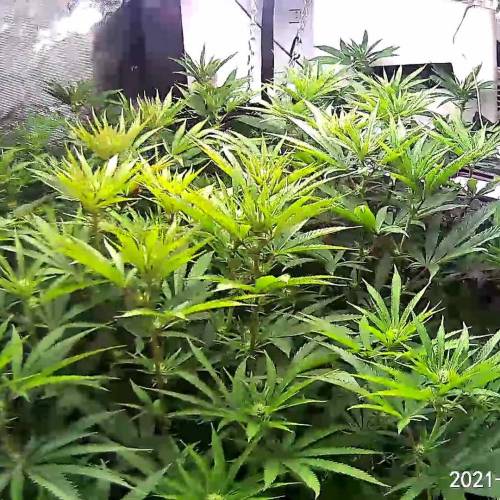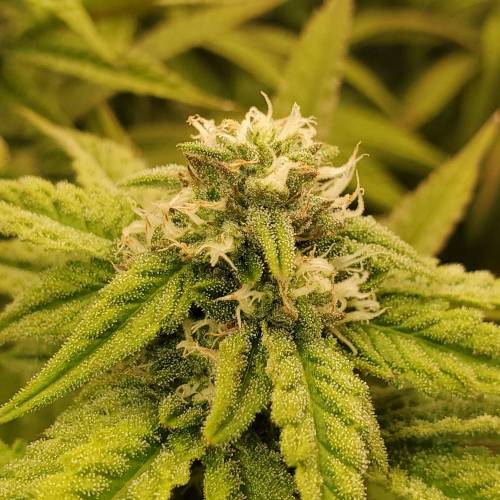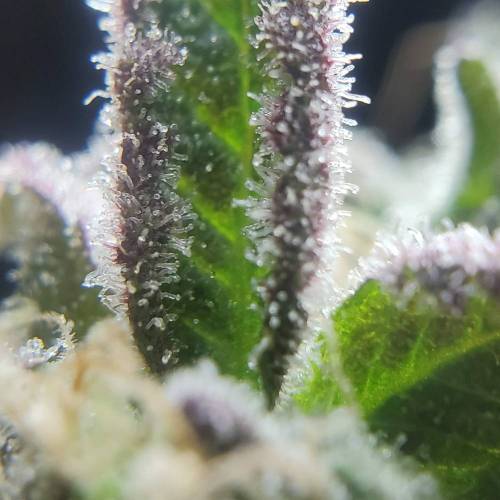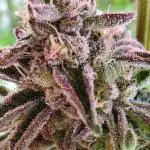The Grow Awards 2026 🏆 

































"Grand Daddy Purp" C#2

FLO
30w far red Fluorescent/150W
30w far red
Perlite
Vermiculite
Coco Coir
Volcanic Rock Other
Pumice Other
Ground Sphagum Moss Other
Stepwell Supersoil Other
Crab Chitin Other
Black Fly Other
Charcoal Other
Indoor
Room Type
Defoliation
weeks 7, 15-17
weeks 17
FIMing
weeks 3
SoG
weeks 6
ScrOG
weeks 6-7
LST
weeks 7, 9
HST
weeks 7, 9
Topping
weeks 7, 9
19 liters
Pot Size
3.79 liters
Watering
Start at Harvest
G
Germination4y ago
Ultraviolet Soaked seeds in pure coconut water for 24 hours @ 78 degrees F before leaving in humidity dome @80RH/85degree for remainder of germination.
BLOOM PLUS 4000
Plants are fully grounded to Earth at root level.
Abstract
Sound waves technology has been applied to different plants. It has been found that sound waves were at different frequencies, sound pressure levels (SPLs), exposure periods, and distances from the source of sound influence plant growth. Experiments have been conducted in the open field and under greenhouse growing conditions with different levels of audible sound frequencies and sound pressure levels. Sound waves at 1 kHz and 100 dB for 1 h within a distance of 0.20 m could significantly promote the division and cell wall fluidity of callus cells and also significantly enhance the activity of protective enzymes and endogenous hormones. Sound waves stimulation could increase the plant plasma-membrane H+-ATPase activity, the contents of soluble sugar, soluble protein, and amylase activity of callus. Moreover, sound waves could increase the content of RNA and the level of transcription. Stress-induced genes could switch on under sound stimulation. Sound waves at 0.1–1 kHz and SPL of (70±5) dB for 3 h from plant acoustic frequency technology (PAFT) generator within a distance ranged from 30 to 60 m every other day significantly increased the yield of sweet pepper, cucumber and tomato by 30.05, 37.1 and 13.2%, respectively. Furthermore, the yield of lettuce, spinach, cotton, rice, and wheat were increased by 19.6, 22.7, 11.4, 5.7, and 17.0%, respectively. Sound waves may also strengthen plant immune systems. It has been proved that spider mite, aphids, gray mold, late blight and virus disease of tomatoes in the greenhouses decreased by 6.0, 8.0, 9.0, 11.0, and 8.0%, respectively, and the sheath blight of rice was reduced by 50%. This paper provides an overview of literature for the effects of sound waves on various growth parameters of plant at different growth stages.
7 likes
comments
Share
Used method
Paper Towel
Germination Method
1
Week 1. Vegetation4y ago
5.08 cm
Height
18 hrs
Light Schedule
25 °C
Day Air Temp
6.0
pH
No Smell
Smell
100 PPM
TDS
50 %
Air Humidity
23 °C
Solution Temp
23 °C
Substrate Temp
23 °C
Night Air Temp
18.93 liters
Pot Size
3.79 liters
Watering Volume
45.72 cm
Lamp Distance
900 PPM
CO₂ Level
Nutrients 2
Coconut Water
100 mll

Mycorrhizal Inoculant
50 mll
Ultraviolet jjjj
7 likes
comments
Share
2
Week 2. Vegetation4y ago
12.7 cm
Height
18 hrs
Light Schedule
25 °C
Day Air Temp
6.0
pH
No Smell
Smell
100 PPM
TDS
45 %
Air Humidity
23 °C
Solution Temp
21 °C
Substrate Temp
23 °C
Night Air Temp
3.79 liters
Pot Size
3.79 liters
Watering Volume
45.72 cm
Lamp Distance
1000 PPM
CO₂ Level
5 likes
comments
Share
3
Week 3. Vegetation4y ago
20.32 cm
Height
18 hrs
Light Schedule
25 °C
Day Air Temp
6.0
pH
No Smell
Smell
100 PPM
TDS
45 %
Air Humidity
23 °C
Solution Temp
21 °C
Substrate Temp
22 °C
Night Air Temp
3.79 liters
Pot Size
3.79 liters
Watering Volume
15.24 cm
Lamp Distance
850 PPM
CO₂ Level
Ultraviolet Blah blah blah
5 likes
comments
Share
Used techniques
FIMing
Technique
4
Week 4. Vegetation4y ago
101.6 cm
Height
18 hrs
Light Schedule
25 °C
Day Air Temp
6.5
pH
No Smell
Smell
100 PPM
TDS
35 %
Air Humidity
23 °C
Solution Temp
21 °C
Substrate Temp
17 °C
Night Air Temp
3.79 liters
Pot Size
3.79 liters
Watering Volume
15.24 cm
Lamp Distance
800 PPM
CO₂ Level
Ultraviolet Transplanted to 5 gallon Air Pruning Pots.
PH Running higher than desired added Aluminum Sulphate to acidify the soil back to 6.0
5 likes
comments
Share
5
Week 5. Vegetation4y ago
101.6 cm
Height
18 hrs
Light Schedule
25 °C
Day Air Temp
6.0
pH
No Smell
Smell
100 PPM
TDS
45 %
Air Humidity
23 °C
Solution Temp
21 °C
Substrate Temp
22 °C
Night Air Temp
18.93 liters
Pot Size
3.79 liters
Watering Volume
45.72 cm
Lamp Distance
800 PPM
CO₂ Level
Nutrients 1

Mycorrhizal Inoculant
1.302 mll
Ultraviolet Messed up again during transplant to 5 gallon air pruners, was impatient and didn't give enough time for the soil to dry before attempting transplant, soil gave way mid transfer, in my folly of trying to catch it to hold it together I snapped her at the root of the stem. I didn't realize until right then how quickly you can kill a plant, entire thing went limp instantly, quote upset tbh as it was Lenore who was showing impressive growth. I did not have the knowledge or equipment or even experience to have saved her in time. It did send me on a quest to learn everything I can about clones and to really dive into plant biology so I could be both prepared and equipped to deal with situations in future. She was a pretty plant. Lessons learned.
Filled transplant soil with Dynomyco Mycorrihzal inoculant.
6 likes
comments
Share
6
Week 6. Vegetation4y ago
101.6 cm
Height
18 hrs
Light Schedule
25 °C
Day Air Temp
6.0
pH
No Smell
Smell
100 PPM
TDS
45 %
Air Humidity
23 °C
Solution Temp
21 °C
Substrate Temp
22 °C
Night Air Temp
18.93 liters
Pot Size
3.79 liters
Watering Volume
45.72 cm
Lamp Distance
900 PPM
CO₂ Level
Ultraviolet To be updated shortly backdating and organizing information
5 likes
comments
Share
Used techniques
SoG
Technique
ScrOG
Technique
7
Week 7. Vegetation4y ago
101.6 cm
Height
18 hrs
Light Schedule
25 °C
Day Air Temp
6.0
pH
No Smell
Smell
100 PPM
TDS
45 %
Air Humidity
23 °C
Solution Temp
21 °C
Substrate Temp
22 °C
Night Air Temp
18.93 liters
Pot Size
3.79 liters
Watering Volume
45.72 cm
Lamp Distance
900 PPM
CO₂ Level
Ultraviolet Brb
5 likes
comments
Share
Used techniques
LST
Technique
HST
Technique
ScrOG
Technique
Topping
Technique
Defoliation
Technique
8
Week 8. Vegetation4y ago
101.6 cm
Height
16 hrs
Light Schedule
25 °C
Day Air Temp
6.0
pH
No Smell
Smell
100 PPM
TDS
45 %
Air Humidity
23 °C
Solution Temp
21 °C
Substrate Temp
17 °C
Night Air Temp
18.93 liters
Pot Size
3.79 liters
Watering Volume
40.64 cm
Lamp Distance
1200 PPM
CO₂ Level
Ultraviolet To be updated shortly backdating and organizing information
5 likes
comments
Share
9
Week 9. Vegetation4y ago
101.6 cm
Height
14 hrs
Light Schedule
25 °C
Day Air Temp
6.8
pH
No Smell
Smell
100 PPM
TDS
45 %
Air Humidity
23 °C
Solution Temp
21 °C
Substrate Temp
21 °C
Night Air Temp
18.93 liters
Pot Size
3.79 liters
Watering Volume
30.48 cm
Lamp Distance
1100 PPM
CO₂ Level
Ultraviolet To be updated shortly backdating and organizing information
5 likes
comments
Share
Used techniques
LST
Technique
HST
Technique
Topping
Technique
10
Week 10. Vegetation4y ago
101.6 cm
Height
13 hrs
Light Schedule
25 °C
Day Air Temp
6.0
pH
No Smell
Smell
100 PPM
TDS
45 %
Air Humidity
23 °C
Solution Temp
21 °C
Substrate Temp
17 °C
Night Air Temp
18.93 liters
Pot Size
3.79 liters
Watering Volume
15.24 cm
Lamp Distance
1000 PPM
CO₂ Level
Ultraviolet Started UV through the week, Solacure Flower Power, worked up to 4 hours to give plants time to adjust.
7 likes
comments
Share
11
Week 11. Flowering4y ago
101.6 cm
Height
12 hrs
Light Schedule
25 °C
Day Air Temp
6.0
pH
No Smell
Smell
100 PPM
TDS
45 %
Air Humidity
25 °C
Solution Temp
21 °C
Substrate Temp
17 °C
Night Air Temp
18.93 liters
Pot Size
3.79 liters
Watering Volume
30.48 cm
Lamp Distance
900 PPM
CO₂ Level
Nutrients 3

RAW Potassium
50 mll

Microbes Bloom Stage
5 mll

RAW Amino Acids
5 mll
Ultraviolet To be updated shortly backdating and organizing information
5 likes
comments
Share
12
Week 12. Flowering4y ago
101.6 cm
Height
12 hrs
Light Schedule
25 °C
Day Air Temp
6.0
pH
Normal
Smell
100 PPM
TDS
40 %
Air Humidity
25 °C
Solution Temp
21 °C
Substrate Temp
17 °C
Night Air Temp
18.93 liters
Pot Size
3.79 liters
Watering Volume
15.24 cm
Lamp Distance
700 PPM
CO₂ Level
Ultraviolet ggggggggggggggggggggggggggggggggggggggggggggggggggggggggg
6 likes
comments
Share
13
Week 13. Flowering4y ago
101.6 cm
Height
12 hrs
Light Schedule
25 °C
Day Air Temp
6.0
pH
No Smell
Smell
100 PPM
TDS
40 %
Air Humidity
25 °C
Solution Temp
21 °C
Substrate Temp
17 °C
Night Air Temp
18.93 liters
Pot Size
3.79 liters
Watering Volume
30.48 cm
Lamp Distance
1200 PPM
CO₂ Level
Nutrients 2

RAW Silica
0.326 mll

RAW Cane Molasses
0.651 mll
Ultraviolet To be updated shortly backdating and organizing information
5 likes
comments
Share
14
Week 14. Flowering4y ago
101.6 cm
Height
10 hrs
Light Schedule
25 °C
Day Air Temp
6.0
pH
Weak
Smell
100 PPM
TDS
40 %
Air Humidity
25 °C
Solution Temp
21 °C
Substrate Temp
17 °C
Night Air Temp
18.93 liters
Pot Size
3.79 liters
Watering Volume
15.24 cm
Lamp Distance
1000 PPM
CO₂ Level
Nutrients 2

RAW Silica
0.326 mll

RAW Cane Molasses
0.651 mll
Ultraviolet To be updated shortly backdating and organizing information
5 likes
1 comment
Share
15
Week 15. Flowering4y ago
101.6 cm
Height
10 hrs
Light Schedule
25 °C
Day Air Temp
6.0
pH
Weak
Smell
100 PPM
TDS
40 %
Air Humidity
23 °C
Solution Temp
21 °C
Substrate Temp
17 °C
Night Air Temp
18.93 liters
Pot Size
3.79 liters
Watering Volume
20.32 cm
Lamp Distance
1000 PPM
CO₂ Level
Nutrients 15

RAW Silica
0.326 mll

Microbes Bloom Stage
0.326 mll

RAW Calcium / Mag
0.651 mll
Ultraviolet Once the stretch was over I threw in supplemental lighting firing it from the bottom up (along with sides) I have already been defoliating nearly all fan leaves except from the satellite leaves up top (top 4 nodes) this was done gradually over the flowering period and reached its peak in conjunction with the end of the stretch. Testing for personal experience to see if throwing light from all angles and its effect. Also slamming it with 2hours 280nm Solacure UVB with 30min Far-red for breakfast 5 hours Lights on, 30min Far-red to sleep and 2 hours of UVB then 14 hours of dark.
6 likes
1 comment
Share
Used techniques
Defoliation
Technique
16
Week 16. Flowering4y ago
101.6 cm
Height
8 hrs
Light Schedule
25 °C
Day Air Temp
6.0
pH
Normal
Smell
100 PPM
TDS
40 %
Air Humidity
25 °C
Solution Temp
21 °C
Substrate Temp
17 °C
Night Air Temp
18.93 liters
Pot Size
3.79 liters
Watering Volume
15.24 cm
Lamp Distance
1000 PPM
CO₂ Level
Nutrients 15

RAW Silica
0.326 mll

Microbes Bloom Stage
0.326 mll

RAW Calcium / Mag
0.651 mll
Ultraviolet Steady she goes, finally starting to thicken bud sites was worried there was a delay, 1 Plant out of the 3 is showing accelerated purple hues, must be genetically more inclined to purple, either that closest to the AC unit.
9 likes
comments
Share
Used techniques
Defoliation
Technique
17
Week 17. Flowering4y ago
101.6 cm
Height
8 hrs
Light Schedule
25 °C
Day Air Temp
6.0
pH
100 PPM
TDS
35 %
Air Humidity
23 °C
Solution Temp
21 °C
Substrate Temp
17 °C
Night Air Temp
18.93 liters
Pot Size
3.79 liters
Watering Volume
15.24 cm
Lamp Distance
1000 PPM
CO₂ Level
Nutrients 2

RAW Silica
0.33 mll

RAW Cane Molasses
0.65 mll
Ultraviolet ffff
12 likes
2 comments
Share
Used techniques
Defoliation
Technique
0
Technique
18
Week 18. Flowering4y ago
101.6 cm
Height
8 hrs
Light Schedule
25 °C
Day Air Temp
6.0
pH
Strong
Smell
100 PPM
TDS
35 %
Air Humidity
23 °C
Solution Temp
21 °C
Substrate Temp
17 °C
Night Air Temp
18.93 liters
Pot Size
3.79 liters
Watering Volume
25.4 cm
Lamp Distance
1000 PPM
CO₂ Level
Ultraviolet Terpenes are aromatic compounds that give cannabis some of its most distinct aromas from citrus and berry, to more earthy tones. Many species of plants produce and emit terpenes in a diurnal, or daily cycle that is regulated by a complex web of signaling. There are also many plants that emit terpenes at night to attract nocturnal pollinators (Marinho et al., 2014346). Regardless of when the terpenes are produced or emitted, these processes are often dependent upon cues derived from natural light/dark cycles via a native circadian clock (Dudareva et al., 2004). Several light-sensitive pigments are involved in these processes of production and emission, and the different photoreceptors are dependent upon different wavelengths of light to be activated or deactivated. Emission of terpenes is a process that is entirely dependent upon phytochromes and red/far-red light cues in most plant species (Flores and Doskey, 2015). For example, repeated light/dark phytochrome signaling is necessary for the emission of terpenes in tobacco plants (Roeder et al., 2007). Based on previous findings, we hypothesized that a lack of red light and phytochrome-mediated light/dark signaling on the part of the plant is responsible for an increase in terpene content in cannabis. The plant continues to synthesize terpenes, but a lack of red light to trigger the Pr-Pfr shift results in a lack of terpene emission by the plant, thus causing the terpenes to accumulate in the maturing flowers.
REFERENCES
Dudareva N, Pichersky E, Gershenzon J. Biochemistry of Plant Volatiles. Plant Physiology. 2004;135(4):1893-
1902.
Flores, R.M., Doskey, P.V., Estimating Terpene and Terpenoid Emissions from Conifer Oleoresin Composition.
Atmospheric Environment. 2015. 113, 32-40.
Marinho, C.R.; Souza, C.D.; Barros, T.C.; Teixeira, S.P.; Dafni, A. Scent glands in legume flowers. Plant Biology ,
Volume 16 (1) – Jan 1, 2014
Roeder S, Hartmann AM, Effmert U, Piechulla B (2007) Regulation of simultaneous synthesis of floral scent terpenoids by the 1,8-cineole synthase of Nicotiana suaveolens. Plant Mol Biol 65: 107-12
Abstract
Sound waves technology has been applied to different plants. It has been found that sound waves were at different frequencies, sound pressure levels (SPLs), exposure periods, and distances from the source of sound influence plant growth. Experiments have been conducted in the open field and under greenhouse growing conditions with different levels of audible sound frequencies and sound pressure levels. Sound waves at 1 kHz and 100 dB for 1 h within a distance of 0.20 m could significantly promote the division and cell wall fluidity of callus cells and also significantly enhance the activity of protective enzymes and endogenous hormones. Sound waves stimulation could increase the plant plasma-membrane H+-ATPase activity, the contents of soluble sugar, soluble protein, and amylase activity of callus. Moreover, sound waves could increase the content of RNA and the level of transcription. Stress-induced genes could switch on under sound stimulation. Sound waves at 0.1–1 kHz and SPL of (70±5) dB for 3 h from plant acoustic frequency technology (PAFT) generator within a distance ranged from 30 to 60 m every other day significantly increased the yield of sweet pepper, cucumber and tomato by 30.05, 37.1 and 13.2%, respectively. Furthermore, the yield of lettuce, spinach, cotton, rice, and wheat were increased by 19.6, 22.7, 11.4, 5.7, and 17.0%, respectively. Sound waves may also strengthen plant immune systems. It has been proved that spider mite, aphids, gray mold, late blight and virus disease of tomatoes in the greenhouses decreased by 6.0, 8.0, 9.0, 11.0, and 8.0%, respectively, and the sheath blight of rice was reduced by 50%. This paper provides an overview of literature for the effects of sound waves on various growth parameters of plant at different growth stages.
https://doi.org/10.1016/S2095-3119(13)60492-X
17 likes
6 comments
Share
18
Week 18. Harvest4y ago
Happy Harvest Day!

9/10
Rated
Quality was out of this world, but the quantity was lacking, onwards and upwards.
Show more
Translate
Spent 128 days
Ger Veg Flo Har
266.67 g
Bud wet weight per plant
80 g
Bud dry weight per plant
3
Plants
14.63 m²
Grow Room size
Easy
Difficulty

Relaxed, Sleepy
Positive effects

Dry eyes
Negative effects

Berries, Earthy, Flowery
Taste
Height
Day air temperature
Air humidity
PPM
PH
CO2
Light schedule
Solution temperature
Night air temperature
Substrate temperature
Pot size
Lamp distance
Ultraviolet Vigorous.
17 likes
6 comments
Share
Equipment Reviews

the end.
Enjoying this diary? Follow for more updates!
Prefer the old Diary view?
Go back to the old Diary view





























































